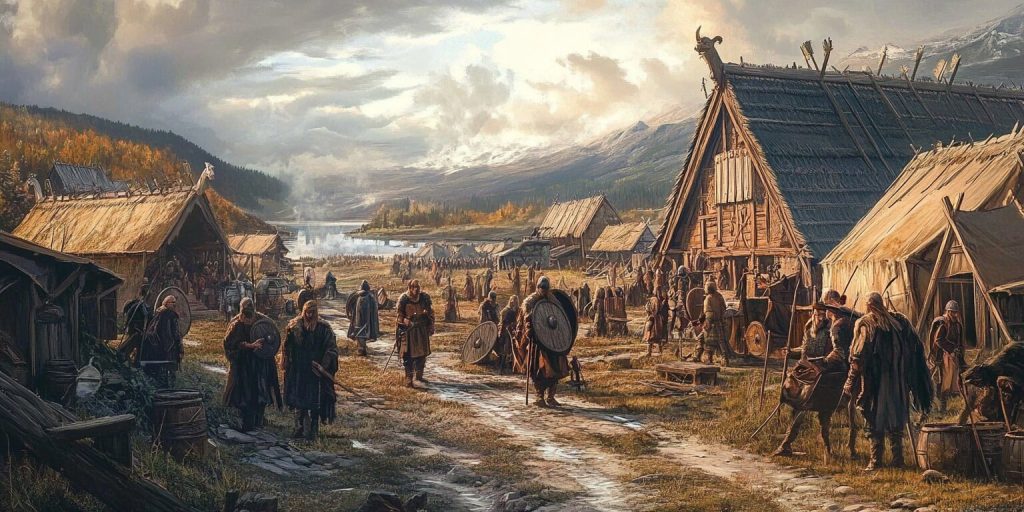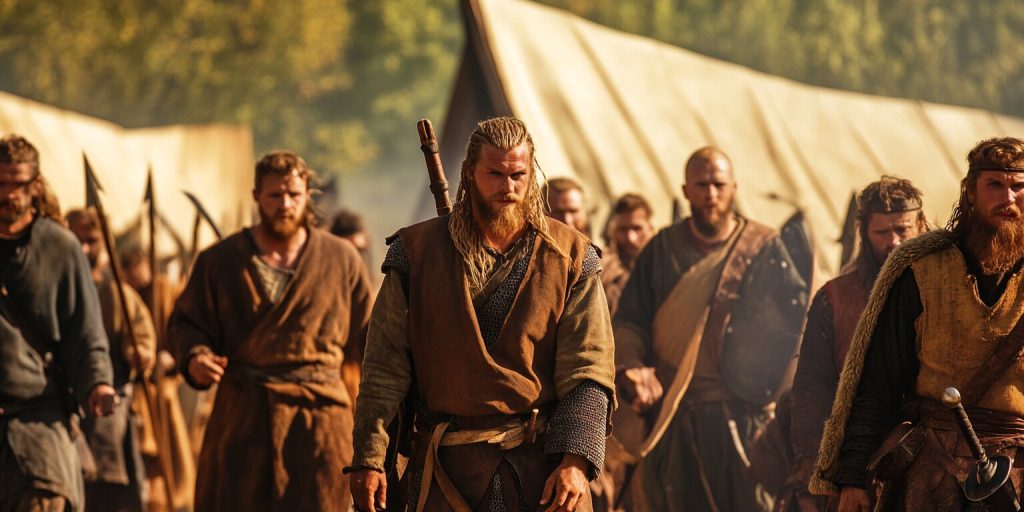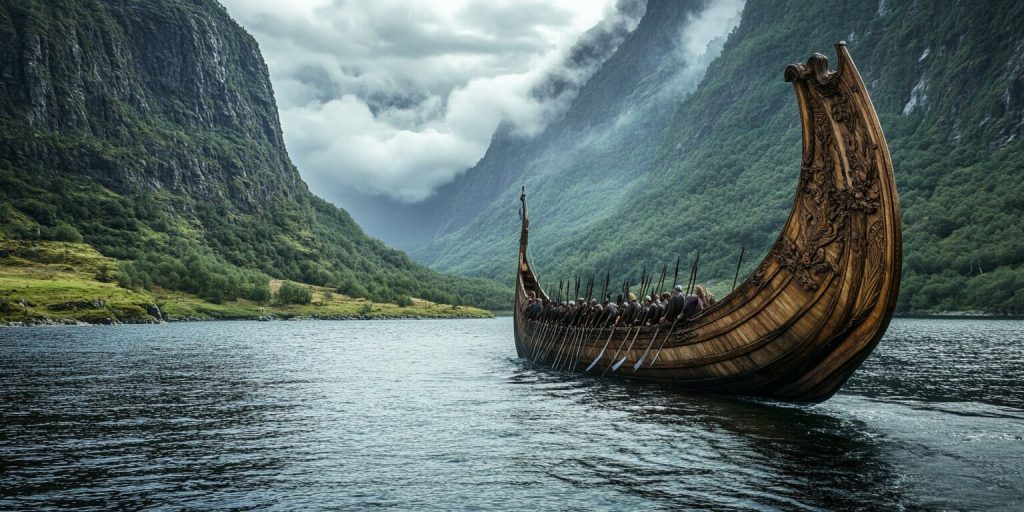Viking Heritage, Viking Raids and Warfare, Viking Ships, Viking Trade and Commerce, Vikings
How Did the Vikings Move?
The Vikings were known for their great seafaring skills. Like today’s long-distance moving services, they moved long distances. They raided, traded, and searched for new lands to settle in.
To understand why did the Vikings move to Britain and how they did so, we must look at their amazing ability to navigate the sea. This skill was key to their success in exploring and expanding across Europe and North America.
The Vikings used advanced navigation techniques and built strong ships, crucial for their journeys and discoveries.
The Beginnings of the Viking Movement: Exploring the Scandinavian Roots
The Viking Age began with major explorations and cultural growth in Norway, Denmark, and Sweden. These places started a lively Viking society driven by adventure, fighting, and trade.
The Influence of Norse Culture
Norse culture deeply shaped Viking life. Their myths, with gods like Odin and Thor, were key. These stories and epic tales shaped their views and pushed them to explore new lands.
Viking Society and Seafaring Traditions
Viking society was built on amazing sea skills. They made ships like longships to sail oceans and rivers. This skill helped them find new places, wealth, and resources.
The Role of Scandinavian Countries: Norway, Denmark, Sweden
Norway, Denmark, and Sweden were key in the Viking Age. Norway’s coast helped them learn to sail. Denmark was a hub for trade with other cultures. Sweden’s big lands gave them resources and places to start their ventures, including settlements in Britain and Ireland.
Together, these countries helped the Viking movement grow. They left a big mark on history.
Viking Ships: The Technological Marvels Behind Their Expansion
Viking ships were key to the Vikings’ wide reach. They were not just for travel but showed advanced engineering and strong craftsmanship.
Types of Viking Ships: Longships and Knarrs
Viking ships were of two main types: Longships and Knarrs. Longships were fast and used for raids and explorations, while knarrs were bigger and carried goods and settlers.
Construction Techniques and Materials Used
Viking shipbuilders used strong materials like oak. They built ships with overlapping planks for strength. This method, along with watertight seals, made the vessel seaworthy.
The Role of Shipbuilding in Viking Society
Shipbuilding was vital in Viking society, leading to the creation of advanced vessels displayed in the Viking Ship Museum. Shipbuilders were respected, and their skills were passed down. This industry supported trade and military efforts and was key to the community’s life.
Navigation Skills and Maritime Innovations
Viking success at sea came from their navigation skills and innovations. They used the sun, bird patterns, and possibly the astrolabe to navigate. These methods helped them find distant shores and settle in new places.
Where Did the Vikings Move To?
The Vikings were known for their skill in sailing. They moved far from their homes in Scandinavia. They settled in many places, leaving a big mark.

Colonization of the British Isles: England, Ireland, and Scotland
The Vikings went to the British Isles, settled in England, Ireland, and Scotland, and mixed their ways with the locals, changing history and creating a unique Viking culture.
They didn’t just raid. They also traded and ruled, becoming a big part of the area’s life.
The Expeditions to Greenland and North America
The Vikings also went to Greenland and North America. Erik the Red led them to Greenland, where they stayed for a long time.
Then, they sailed to North America. Archaeologists found signs of them at L’Anse aux Meadows, showing they were brave explorers.
Settlements in Continental Europe: France and Beyond
The Vikings didn’t stop at the British Isles and the North Atlantic. They also settled in Europe, like Normandy in France, and their presence changed history there.
They came with raids and peace. Their influence is still seen in European buildings, culture, and genes.
The Reasons Behind the Viking Movement
The Viking movement was driven by many factors, including the Vikings’ history. These included economic needs, environmental pressures, and political goals, which helped explain why Vikings expanded their territories and engaged in pillage.
Economic Factors: Trade and Plunder
Economic needs like trade and plunder were key. Vikings sought wealth by trading goods and raiding. This wealth helped their communities grow.
Environmental Pressures: Climate Changes
Climate changes were also important. Harsh weather in Scandinavia led to food shortages. So, Vikings moved to better places for resources and survival.
Political Motivations: Warfare and Settlement
Politics played a big role, too. Vikings wanted to settle new lands and expand their influence. They used warfare to control new areas. Successful raids helped them establish new settlements and spread their culture.
The Impact of Viking Raids and Settlements on Europe
The Viking era greatly changed Europe. Their raids and settlements affected many areas, including trade, economy, culture, and language.
Changes in European Trade and Economy
The Viking raids greatly changed European trade. They helped create new trade routes and places, which grew the economy in many areas.
Coastal and inland places saw more trade, reflecting the influence of Norwegian Vikings. This helped the economy grow. The Vikings helped share goods, ideas, and new things across Europe.
Influence on European Culture and Language
The Vikings also changed European culture and language. They introduced Norse elements into art, literature, and society, which greatly impacted many European cultures.
They also helped change local languages. Old Norse words mixed into local dialects, making languages richer in the areas they visited.
The Legacy of Viking Settlements
The Viking legacy is still in their settlements, part of Europe’s history and geography. The Vikings mixed Norse and local ways that still exist.
Buildings and artifacts show their lasting impact. The Viking legacy is a key part of European history.
Viking Settlements in Greenland and North America
The Vikings, led by Erik the Red and his son Leif Erikson, made big moves. They set up settlements in places far from home. This was a big deal in history and geography.
Erik the Red and the Founding of Greenland
Erik the Red was known for his boldness and fiery temper. He was exiled from Iceland and found Greenland around 985 AD. He made it a home for the Norse people, starting a new chapter in Viking history.
Leif Erikson and the Ventures into Vinland
Leif Erikson followed his father’s path, exploring even further. Around 1000 AD, he found Vinland, now thought to be Newfoundland. This place was full of resources, showing the Vikings’ reach.
Archaeological Evidence from L’Anse aux Meadows
The site at L’Anse aux Meadows in Newfoundland is key. It was found in the 1960s and shows Norse buildings and tools. This proof confirms the Vikings’ journey to North America.
Erik the Red and Leif Erikson’s adventures show the Vikings’ skill and bravery. Their stories and discoveries still excite and inspire today.
Challenges Faced by the Vikings: From Raid to Settlement
The Vikings had to change from warriors to settlers, which was a big challenge. They also had to adapt to new places and ways of life.

Adapting to New Environments
The Vikings settled in many places and had to get used to different climates and soils. This was key to their survival and success.
Conflict with Indigenous Populations
Viking expansion led to fights with native people in places like the British Isles and the New World. The Vikings wanted land and power, leading to conflicts.
The End of the Viking Age: 1066 and the Battle of Stamford Bridge
The Battle of Stamford Bridge in 1066 was a turning point. It showed the end of the Viking Age. The Vikings faced many challenges and were defeated by Harold Godwinson’s forces.
The Role of Viking Women in Migration and Settlement
Viking women were key in moving and settling in new places. They took care of the home, which was vital for Norse society. They ensured life was smooth when moving to new lands, often establishing monasteries for trade and cultural exchange.
They also worked on the land, cared for animals, and got food. This was crucial for Viking communities to survive and grow, especially during the year 793. Their work in agriculture showed how important they were in migration and settlement.
Some Viking women were also in trade. This showed their ability to adapt and help the economy. Their work in trade helped Viking society grow and expand, particularly in Britain and Ireland.
Viking women’s roles in Norse society are often overlooked. But they were essential to the development of Viking culture. They supported daily life and shaped the communities they helped create. The Vikings’ success in migration and settlement was thanks to the hard work of Viking women.
Conclusion
The Viking Age was a key period in history. Norse explorers from Scandinavia traveled far, from the British Isles to North America, and showed great mobility and resilience.
Their skills in sailing and adapting to new places still fascinate many. This legacy is why people love to learn about the Vikings.
Vikings did more than raid. They changed European trade and economy, brought new cultures and languages, and made lasting settlements.
Their expansion was driven by money, climate, and politics. These reasons still interest scholars today.
In short, the Vikings’ travels and settlements were more than just exploration. They were key moments in European history. Their story is one of curiosity, spirit, and lasting impact.
The Vikings’ journey from Scandinavia to the Atlantic in 793 shows their incredible influence on European history. Their legacy is truly remarkable.

